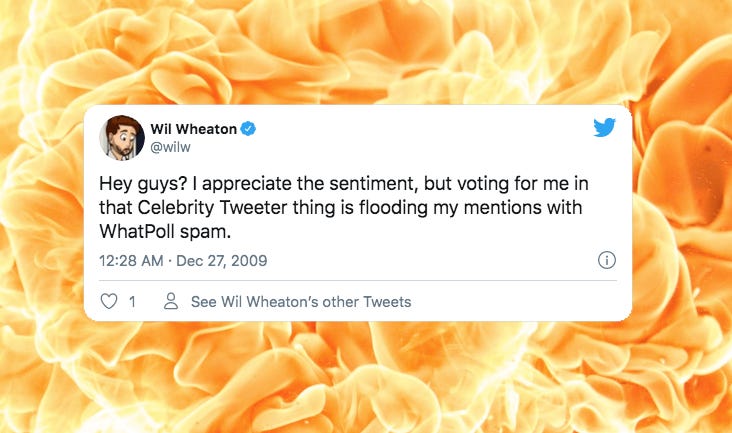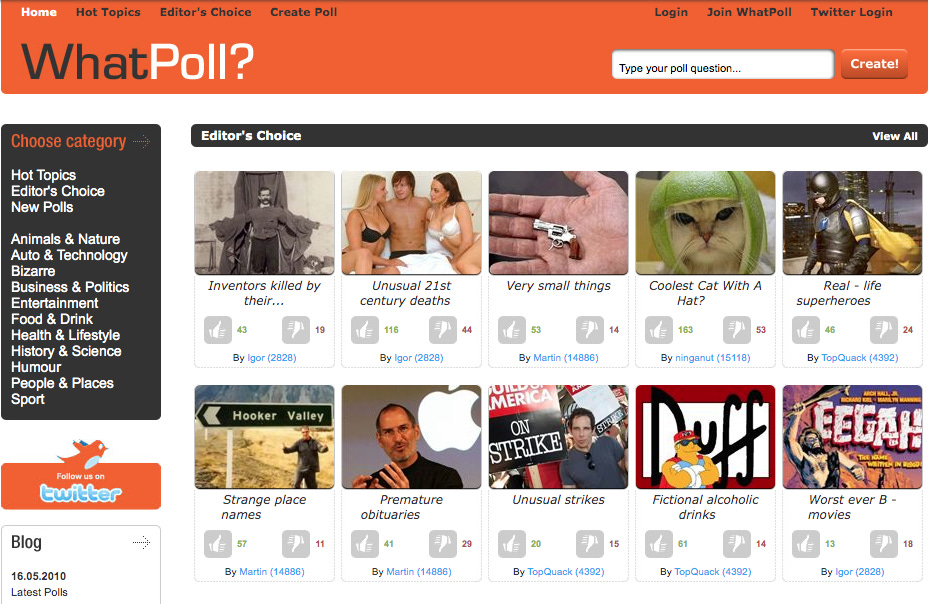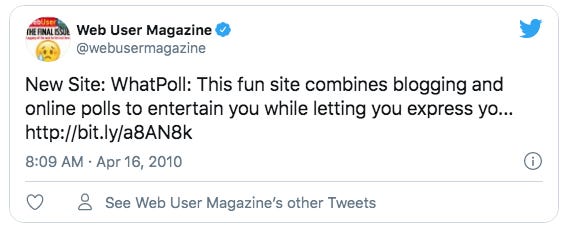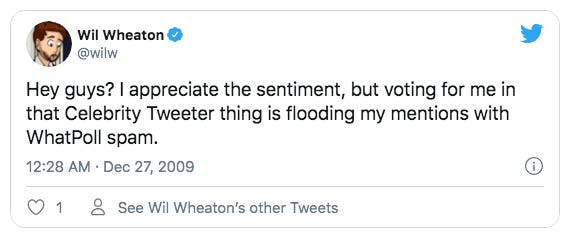My First Product ‘Broke’ Twitter and Then Crashed Hard
Celebrities were “harmed” in the making of this story.
Hello 👋
Martin here. Welcome to another edition of Founders’ Hustle!
I produce content about the “hustle” of entrepreneurship and building startups.
Today, I’m sharing what happened at my first ever product launch!
For a brief moment we thought we were onto something “big”. 🚀
But, it turned out to be a flash in the pan. 💥
And, we kind of “broke” Twitter along the way. 🙈

It was late 2009. I was working in a corporate banking job and had just launched my first ever product online as a “side hustle”.
It was a “social polling” network called WhatPoll?
Basically, a website where you could vote up or down on things in lists about movies, restaurants, historical facts, etc and “debate” the merits with others.
The idea was to build up an engaged community and then monetize via advertising and affiliate partners.
I had spent the previous year reading a ton of literature about building Internet businesses and companies in general — search engine optimization, landing page optimization, guerilla marketing, “how they got started” stories, etc.
Despite that, there wasn’t really a user acquisition or growth plan. And, by that I mean our approach was just to launch and “figure it out”.
There was certainly no paid advertising budget, so we’d have to get creative.
To give you a feel for the site, below is a homepage screenshot.
Yes, it was basic and looks very dated today! But, “good enough” to test our hypothesis.
Launch day was soon upon us, which basically just involved pushing the website live. Then nothing much happened.
*crickets*
For a while, the only people visiting the site was myself and other founders. No presence on Google. No traffic deals. No social traffic. No network to tap into. Nothing.
So, we started to experiment with ideas and made some adjustments.
First up, we introduced polls that were of a more compelling nature to consume — humor and curiosity. The intention being it would make the site more shareable on social media and other websites.
So, instead of a generic list like “Best Disney Movie” it would be stuff like “Strange Place Names” or “Coolest Cat With a Hat”.
This had little impact in the beginning but later worked to a degree.
We’d occasionally get blasts of traffic to polls from social bookmarking sites like Fark or Reddit, and mentions from other media outlets.
We quickly grew impatient and wanted to get our product “out there” in a big way. So, other ideas were researched and “brainstormed”.
This led to an interest in a relatively new feature Twitter had launched, Apps — integrated through an API.
We observed that another polling website was using this functionality to generate traffic to their website. Someone would vote, and it would automatically tweet their choice.
So, pretty quickly, we had our own App up and running.
Now, folks could sign up to our product with Twitter. Every time they voted it would tweet out their choice to their followers automatically, with a link to the poll on our website.
It was engineered in such a way that if people were compelled to vote it would “blow up”. One voter, on average, could spur more than one other person to vote, so the behaviour would grow exponentially.
In the first few days nothing much happened.
*crickets again*
We started “tweet voting” using our own personal Twitter accounts on a range of polls, but this didn’t go anywhere. Not enough followers.
Plus, the subject matter just didn’t resonate enough to compel folks to vote at a rate that would “make it go viral”.
Some questions were raised.
How do we get Twitter “power users” to vote or encourage voting? And, what subject matter would be compelling to their audience?
Then, an idea surfaced.
Partly influenced by the rise of “popularity contest” reality TV shows that had become ever so popular over the preceding decade, we came up with this poll title:
Best celebrity tweeter?
A simple premise. Vote for your favorite tweeting celebrity!
We figured if we could get a handful of celebrities “to bite”, a decent stream of visitors would start flowing our way, which we could use as a mechanism to encourage voting on other polls.
But how? Reaching out directly seemed a bit admin intensive. Plus, there could be “promotion fees” involved by making a formal request.
A subtle adjustment was made. Instead of just using a celebrity’s name in the poll, we also used their @handle.
Every time someone voted, a tweet would be sent with the handle included.
It looked like this:
If you’re familiar with Twitter, you’ll know this means it’ll appear in that particular celebrity user’s “mentions” — these days “notifications” — so it would bring it to their attention.
Due to the number of people trying to contact them, celebrity notifications are super noisy. But, the more people that voted, the more likely they’d see it.
OK, I admit it, this was a spammy user acquisition hack. 😜
Interestingly, celebrities embraced it with much more vigor than I anticipated!
To seed it, we added a ton of them to the poll and started voting from our own accounts a lot.
Every time we did this, which took seconds, tweets were sent out with a celebrity @handle in.
Quickly, the poll got noticed.
A few celebrities retweeted. Their followers starting voting.
More celebrities noticed. Their followers started voting.
This loop amplified fast.
It turned into a public competition. Some celebrities were rallying their followers to vote for them many times per day to try to hit the spot #1 in the poll.
“Fan club” accounts for things like Harry Potter and pop stars got involved.
Then, entire sub-communities like K-Pop who voted like crazy.
It got “out of control”.
Within hours traffic to our website skyrocketed and tens of thousands of votes were being cast, all tagging in celebrities with their @handle.
This clogged up their “mentions” and made that feature hard to use.
While some seemed to be embracing “the fun”, complaints understandably started to roll in.
Conscious of the fact we were “breaking” the Twitter experience for those users, we started to remove those that objected from the poll.
Overall, it wasn’t many, so voting kept going up.
It reached a point where, due to the intensity and scale of voting, it became “over-saturated” and “too visible” on the platform.
In addition to user experience issues, we started to develop serious concerns that Twitter would disable our app if this dynamic continued on its current trajectory. It was only a matter of time.
So, we removed the functionality where voting included the celebrity’s @handle. No more “mention spamming”.
As a result, voting and visitors to our website veered off sharply. Like, crashed.
In the retrospective of this initiative, there's a couple of key takeaways.
First up, tapping into the “psychological motivators” and “established behaviours” of a big network or platform can be an extremely powerful “free” user acquisition channel.
How you insert yourself into the “conversation” is the difference between success or failure. Take time to understand the nuances and mechanisms of activity.
It was only after trial and error that we figured out how to calibrate a poll that “blew up”.
Secondly, user acquisition “isn’t everything” — particularly if it isn’t sustainable.
You’ll have to continually “push” target customers to your property (app or website) until you figure out how to make it “sticky”. This will likely be heavily loss-making in money or time for the near term. You’ll need to “budget” to last the duration.
In our case, most people coming from Twitter would vote and then leave. Only a very small percentage explored other polls and voted on them. The majority never came back at all.
We followed this up with other polls that were engineered to “go viral” in a more sustainable manner and made tweaks to the website try and improve metrics.
These initiatives brought in a lot of visitors, but ultimately it proved tricky to encourage them to hang around for long periods of time or return later.
In order to build a successful business we’d have to persistently make ourselves visible to folks in the places they were hanging out.
Our website wasn’t a “hang out” destination in itself. It was a “one-off” transactional use case.
Theoretically there was a path to long term success, but it would have been a fairly long one. SEO, for example.
At the time we didn’t have much patience for that, so we launched a second completely different product, which became a pivot.
Not subscribed to this newsletter? Let’s fix that right now 😉👇






